Bon Paintings (20th Century)

A small group of 20th century Bon Paintings have been added to the database.


A small group of 20th century Bon Paintings have been added to the database.

Page illuminations are commonly found in Tibetan religious texts. The seven examples represented here depict lineage teachers of the Taglung Kagyu tradition.
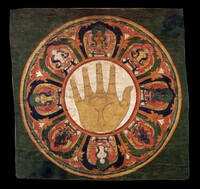
The Himalayan Art Resources website was established in 1997. The 15th Anniversary has actually passed as of several months ago without fanfare. At that time the HAR staff were extremely busy with new collections and cataloguing and did not have the opportunity to make announcements or celebrate.
Today, for the record, we announce our belated 15th anniversary. We have put together a list of 15 Interesting Facts about HAR and the 15 Major Improvements that have happened over the previous 15 years.
The future is bright for HAR with the participation of many more museums and private collections. Research and cataloguing is always ongoing along with many improvements for usability, search functions and the database. Tibetan and Chinese language navigation, indices and glossaries on the site are nearly complete.
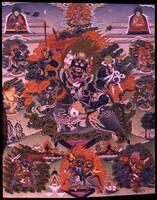
Sipai Gyalmo (Queen of the World) is the principal protector of the Bon Religion. She is the wrathful form of Sherab Chamma. As Sipai Gyalmo she functions both as a meditational deity and a protector. There are six common manifestations (white, yellow, red, black, blue and dark brown) and twenty-eight attendant retinue figures. The Sipai Gyalmo Page has been updated with additional links to less common forms of the deity.
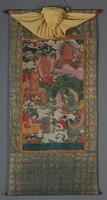
Eleven paintings have been selected to represent the best of the collection from the Beinecke Rare Book & Manuscript Library at Yale University. Only two paintings in the selection are single compositions while the rest are all part of greater sets of paintings numbering a dozen or more. The three most unique paintings are #31757, a Panchen Lama Life Story composition, #31770 a Six-armed form of Amoghapasha and #31763 a Karma Kagyu Lama, likely to be either Trehor Tulku or the 2nd karma Thinlepa.
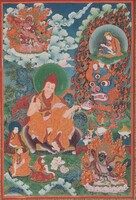
A collection of approximately seventy Himalayan art paintings from the Beinecke Rare Book & Manuscript Library, Yale University, has been added to the HAR Website. The compositions vary greatly as to regional origin but are primarily from the broad areas of Nepal, Tibet, China and Mongolia.
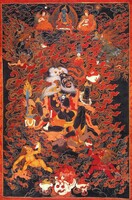
A gallery for Brahmanarupa Mahakala has been added to the Masterworks Page.
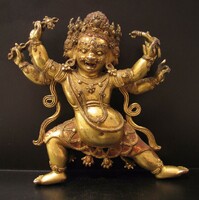
A gallery for Bhurkumkuta has been added to the Masterworks Page.
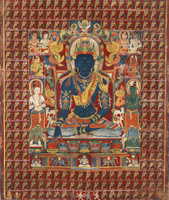
A gallery for Akshobhya Buddha has been added to the Masterworks Page.
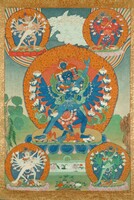
The Five Topics on Colour with regard to Iconography are: the [1] Four Ground Colours, the [2] Four Activities, the [3] Five Buddha Families, the [4] Four Directions & Quadrants of a Mandala and the [5] Multiple Faces of Deities & colour schemata. (A work in progress).
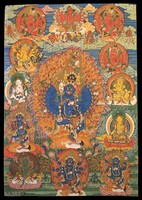
Multiple Faces: The majority of Buddhist Tantric deities only have a single face. Even deities that are commonly known for having multiple faces will most often have a simple form of the deity with only a single face, two arms, two legs and the like. However, many of these deities have a number of different forms which include peaceful appearances, wrathful appearances and multiple faces. (This is a work in progress).
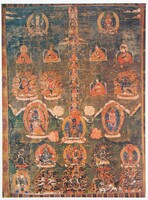
Vertical Lineage: The line of lineage teachers is typically central to a Field of Accumulation painting regardless of tradition. In the text commentaries describing the visualizations and practices the teachers are typically placed either on a flat plane surrounding around a central figure or stacked vertically above the head of the central figure - Vajradhara or Shakyamuni Buddha. Regardless of how the lineage is described in texts, it is very rarely seen or depicted the same way in painting. The three images below each depict a very rare artistic rendering of a vertical lineage of teachers, the figures appearing as if stacked one above the head of another.

A page has been created on the HAR website to organize and list all of the HAR blog submissions to Tricycle Magazine in both chronological and subject order. A list of the posts can also be found by doing a search on the Tricycle website.
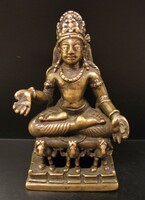
The HAR website Testimonials Page has been updated with a submission by Robert Mayer, University Research Lecturer in Tibetan and Himalayan Studies, The Oriental Institute, Oxford University.
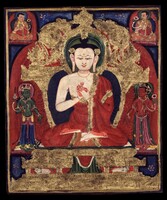
The colour white represents Peaceful Activities, compassion, purification and purity. White is the second most common deity colour in Tantric iconography after blue-black.

In Tantric literature the colour black, or blue-black, along with black coloured deities, represents Wrathful Activities, protection & a fierce resolve of purpose.
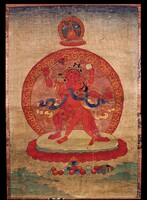
Red coloured deities are very common in Tantric iconography. The red colour relates very closely with Powerful Activities from the group of Four Activities. Probably the the most well known of these deities are Amitabha Buddha, Hayagriva, and Kurukulla.
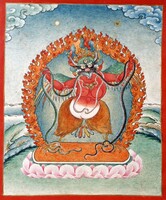
In Tantric iconography there are only a few multi-coloured deities that are commonly represented and known such as Nagaraja Buddha, Kalachakra and Shabala Garuda. Most multi-coloured deities are retinue figures that stand in the intermediate directions in mandala configurations and take on two colours such as for the North-east direction - green and white.
"Introduction: The Archaic Archaeological Sites of Upper Tibet. The upper portion of the Tibetan Plateau, a land of large lakes, lofty peaks, interminable plains, and deep gorges, stretches north and west of Lhasa for 1500 km. Bounded by high mountain ranges on all sides and averaging 4600 m above sea level, Upper Tibet gave rise to an extraordinary civilization in antiquity. Beginning about 3000 years ago, a chain of mountaintop citadels, temples, and intricate burial complexes appeared in this vast region of some 600,000 square kilometers. These monuments were part and parcel of a unique human legacy, which flourished until the Tibetan imperium and the annexation of Upper... Explore!"

The HAR website Testimonials Page has been updated with a submission by John Vincent Bellezza, Senior Research Fellow, Tibet Center, University of Virginia. John's work can be found in numerous publications, the Tibet Archaeology website and on The Tibetan & Himalayan Digital Library.